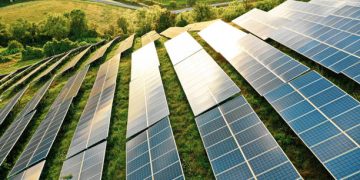BANGKOK — The United States’ planned tariffs on solar panels produced in Southeast Asia could present an opportunity for the region to accelerate its energy transition, experts suggest.
Earlier this month, the US announced plans to impose substantial tariffs on solar panels manufactured in Cambodia, Vietnam, Thailand, and Malaysia. These tariffs follow an investigation into what the US government considered “unfair practices,” particularly involving Chinese-headed firms operating in these countries.
If approved next month, these duties will add to tariffs already imposed by the Trump administration, including a blanket 10-percent levy on solar imports from most countries, and a 145-percent tariff on Chinese-made goods.
The tariffs are expected to have significant consequences for the US solar market. China is a dominant player in global solar panel production, manufacturing approximately 80 percent of the world’s panels and controlling the majority of the production process.
The new tariffs “will practically make solar exports to the US commercially unfeasible,” said Putra Adhiguna, managing director of the Energy Shift Institute think tank.
In 2024, Southeast Asia accounted for nearly 80 percent of US solar panel imports. Despite growing investment in domestic solar production in the US, the market continues to rely heavily on imported components.
The new duties could also impact Chinese manufacturers, many of whom shifted operations to Southeast Asia to avoid tariffs imposed by the US and the European Union.
The proposed tariffs range from around 40 percent on some Malaysian exports to as much as 3,521 percent on solar panels made by some Cambodian manufacturers.
Tariffs Could Accelerate Southeast Asia’s Energy Transition
However, the tariffs may offer an unexpected benefit for Southeast Asia’s energy transition, according to Ben McCarron, managing director at Asia Research & Engagement. He suggests that the tariffs and trade tensions may help speed up the adoption of green energy across the region.
China, in particular, is likely to intensify efforts in regional markets, pushing for policy and plans that enable faster adoption of solar and wind energy.
Analysts have long warned that Southeast Asia is moving too slowly in transitioning away from fossil fuels like coal. According to the energy think tank Ember, the region risks missing out on opportunities provided by the declining costs of renewable energy, which are now cheaper than fossil fuels.
For example, Malaysia relied on fossil fuels for over 80 percent of its electricity generation last year. The country has set a goal to generate 24 percent of its power from renewable sources by 2030, but critics argue this target falls short of global climate goals.
The proposed tariffs represent a dual opportunity for the region, says Muyi Yang, senior energy analyst at Ember. Traditionally, the local solar industry has focused on leveraging domestic resources and labor for export growth. However, the loss of access to the US market may encourage a stronger focus on regional energy transitions, driving faster adoption of green energy domestically and creating new market opportunities.
While this shift presents a significant opportunity, replacing the US market will not be easy. The US remains a key player in global solar demand, and the renewable energy sector in Southeast Asia is still in its early stages.
“Success will depend on turning this export-driven momentum into a homegrown clean-tech revolution,” said Yang.
Some countries in the region may be cautious about an influx of solar panels, prioritizing domestic job creation and trade balance. Major markets such as Indonesia and India have already implemented policies to encourage local solar production.
“Many will hesitate to import large quantities, focusing instead on creating local green jobs and maintaining a favorable trade balance,” Adhiguna noted.
#SolarEnergy #EnergyTransition #SoutheastAsia #RenewableEnergy #GreenEnergy

















